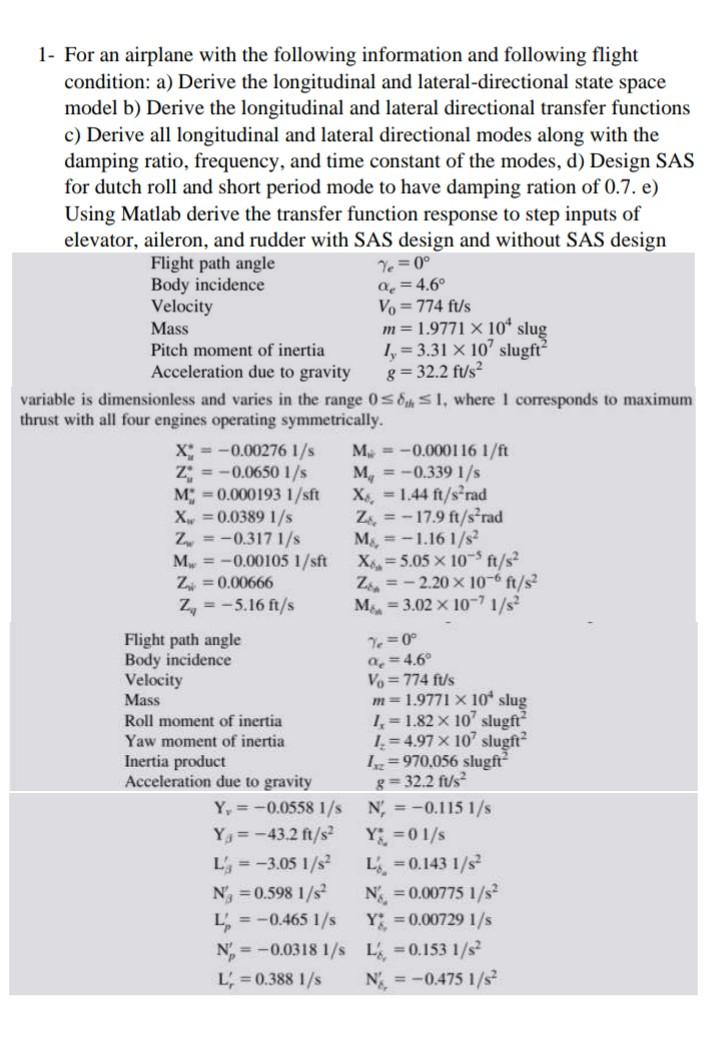Answered step by step
Verified Expert Solution
Question
1 Approved Answer
1- For an airplane with the following information and following flight condition: a) Derive the longitudinal and lateral-directional state space model b) Derive the longitudinal


1- For an airplane with the following information and following flight condition: a) Derive the longitudinal and lateral-directional state space model b) Derive the longitudinal and lateral directional transfer functions c) Derive all longitudinal and lateral directional modes along with the damping ratio, frequency, and time constant of the modes, d) Design SAS for dutch roll and short period mode to have damping ration of 0.7 . e) Using Matlab derive the transfer function response to step inputs of elevator, aileron, and rudder with SAS design and without SAS design variable is dimensionless and varies in the range 0lh1, where 1 corresponds to maximum hrust with all four engines operating symmetrically. Xu=0.002761/sMw=0.000116I/ftZu=0.0650I/sMq=0.3391/sMi=0.0001931/sftX=1.44ft/s2radXw=0.03891/sZq=17.9ft/s2radZw=0.3171/sM=1.161/s2Mw=0.001051/sttXS=5.05105ft/s2Zi=0.00666ZH^=2.20106ft/s2Zv=5.16ft/sMt=3.021071/s2 1- For an airplane with the following information and following flight condition: a) Derive the longitudinal and lateral-directional state space model b) Derive the longitudinal and lateral directional transfer functions c) Derive all longitudinal and lateral directional modes along with the damping ratio, frequency, and time constant of the modes, d) Design SAS for dutch roll and short period mode to have damping ration of 0.7. e) Using Matlab derive the transfer function response to step inputs of elevator, aileron, and rudder with SAS design and without SAS design variable is dimensionless and varies in the range 0th1, where 1 corresponds to maximum thrust with all four engines operating symmetrically. Xu=0.002761/sM=0.000116I/ftZu=0.06501/sMq=0.3391/sMu=0.0001931/sftX,=1.44ft/s2radXw=0.03891/sZs=17.9ft/s2radZw=0.3171/sM6=1.161/s2Mw=0.001051/sttXst=5.05105ft/s2Zi=0.00666ZsA=2.20106ft/s2Zq=5.16ft/sMm=3.021071/s2 Yv=0.05581/sNr=0.1151/sYj=43.2ft/s2Y=01/sL=3.051/s2L=0.1431/s2N3=0.5981/s2Ns=0.007751/s2Lp=0.4651/sY=0.007291/sNp=0.03181/sLf=0.1531/s2Lr=0.3881/sN,=0.4751/s2
Step by Step Solution
There are 3 Steps involved in it
Step: 1

Get Instant Access to Expert-Tailored Solutions
See step-by-step solutions with expert insights and AI powered tools for academic success
Step: 2

Step: 3

Ace Your Homework with AI
Get the answers you need in no time with our AI-driven, step-by-step assistance
Get Started


